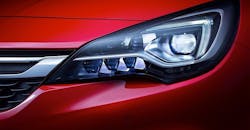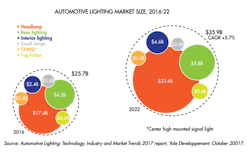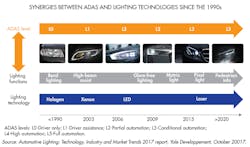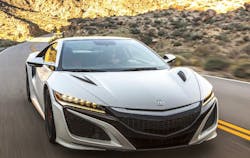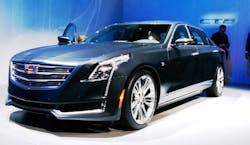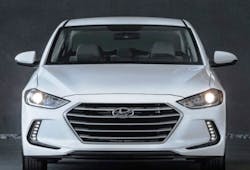LED Lighting Is Gradually Penetrating the Automotive Industry
Automotive lighting growth is driven by natural LED cost erosion, increasing the LED penetration rate. Standardization of LED modules and their optimization are key factors behind decreasing costs. This has resulted in more vehicles equipped with LED technology.
Yole’s detailed analysis of the automotive lighting industry, Automotive Lighting: Technology, Industry and Market Trends 2017, presents all automotive lighting applications and associated market revenue between 2013 and 2022. Yole’s analysts detail the integration status of different lighting technologies and systems, technical trends, market evolution, and market size by application. Automotive lighting is facing an unexpected fast growth combined with technology revolution that will reshape the industry. Figure 1 shows Yole’s automotive lighting market size for 2016 and projections for 2022. Figure 2 illustrates the synergies between automotive lighting technologies since the 1990s for various ADAS lighting functions. Figure 3 shows the market size for suppliers of automotive lighting products in 2016.
1. Yole’s automotive lighting market size for 2016 and 2022 shows the market size for headlamps, rear lights, interior lights, small lamps, CHMSL, and fog lamps.
Since the first full LED headlamp was introduced in 2007, LED technology has gradually penetrated headlamp design. LED technology has allowed lighting to become a distinctive feature and enabled innovative functions like the glare-free adaptive high beam introduced in 2013. LED technology use had been limited to high-end vehicles and has had to compete with traditional light sources, namely halogen and high-intensity discharge (HID/Xenon). Improved LED performance, lower power consumption, and flexible design were the first enablers. Then, cost reductions helped LED technology spread to all vehicle categories.
2. Synergies between automotive lighting technologies since the 1990s.
3. 2016 Automotive lighting market shares.
Automotive lighting is driven by exterior lighting and especially headlamps, generating more than two-thirds of the total market revenue. Rear lighting is the second largest area, representing 17% of total market revenue. Interior lighting represents almost 10% of revenue but growth is expected to be linked to the development of autonomous vehicles and the creation of vehicles as “living homes.” Other types of lighting, such as fog lamps, CHMSL (Center High Mounted signal Lamps), or small lamps composed the remaining 7% of revenue in 2016.
Pierrick Boulay, technology & market analyst at Yole, says, “The automotive lighting industry will be worth $36 billion in 2022. The main reason for lighting growth is that the penetration of LED technology is spreading from high-end cars to mid-range and low-end cars. LED technology propagation and more generally SSL technologies will enable the development of new functionalities.”
The automotive lighting industry is clearly showing remarkable technical advances including emerging technologies based on microLEDs, LCDs, and lasers, explains the consulting company in this report. Advanced Front Lighting System (AFLS) architecture and interaction with sensors are also part of this evolution and well described.
In 2017, LED lighting has found its way into a variety of cars:
- The Acura NSX employs “Jewel Eye” LED headlights that rely on multiple, individual LEDs that slash across the front of the car on either side of the grille, then beam their light through appropriately gem-like lenses. The outer LEDs provide low-beam lighting, the inner units function as high beams, and they combine to serve as front Daylight Running Lights (DRLs) as well.
- Cadillac’s CT6 includes 16 LEDs that flank each headlight in long vertical lines that have emerged as a common design theme for the brand’s products. These LEDs pull double duty as both DRLs and turn-signal indicators, reducing the number of necessary lights.
- LED taillights of the 2017 Hyundai Elantra are adorned by tech-style graphics, creating extra visual flair. There are LED turn-signal indicators available for the car’s exterior mirrors. The front DRLs also reflect brightly to underline the vehicle’s headlights. LED-enabled welcome lighting can shine from the door handles when the car’s keyfob is detected.
- The Mercedes-Benz E-Class provides an LED ambient-lighting system that allows owners to accent the cabin in one of 64 different colors. LED exterior lighting includes a choice between a high-performance headlamp package with “double torch” LED DRL accents and “multibeam” active LEDs. The latter leverages 84 LEDs per headlamp, all capable of being individually controlled to deliver benefits like dynamic-cornering illumination and intelligent adaptive lighting.
About the Author

Sam Davis
Sam Davis was the editor-in-chief of Power Electronics Technology magazine and website that is now part of Electronic Design. He has 18 years experience in electronic engineering design and management, six years in public relations and 25 years as a trade press editor. He holds a BSEE from Case-Western Reserve University, and did graduate work at the same school and UCLA. Sam was the editor for PCIM, the predecessor to Power Electronics Technology, from 1984 to 2004. His engineering experience includes circuit and system design for Litton Systems, Bunker-Ramo, Rocketdyne, and Clevite Corporation.. Design tasks included analog circuits, display systems, power supplies, underwater ordnance systems, and test systems. He also served as a program manager for a Litton Systems Navy program.
Sam is the author of Computer Data Displays, a book published by Prentice-Hall in the U.S. and Japan in 1969. He is also a recipient of the Jesse Neal Award for trade press editorial excellence, and has one patent for naval ship construction that simplifies electronic system integration.
You can also check out his Power Electronics blog.
